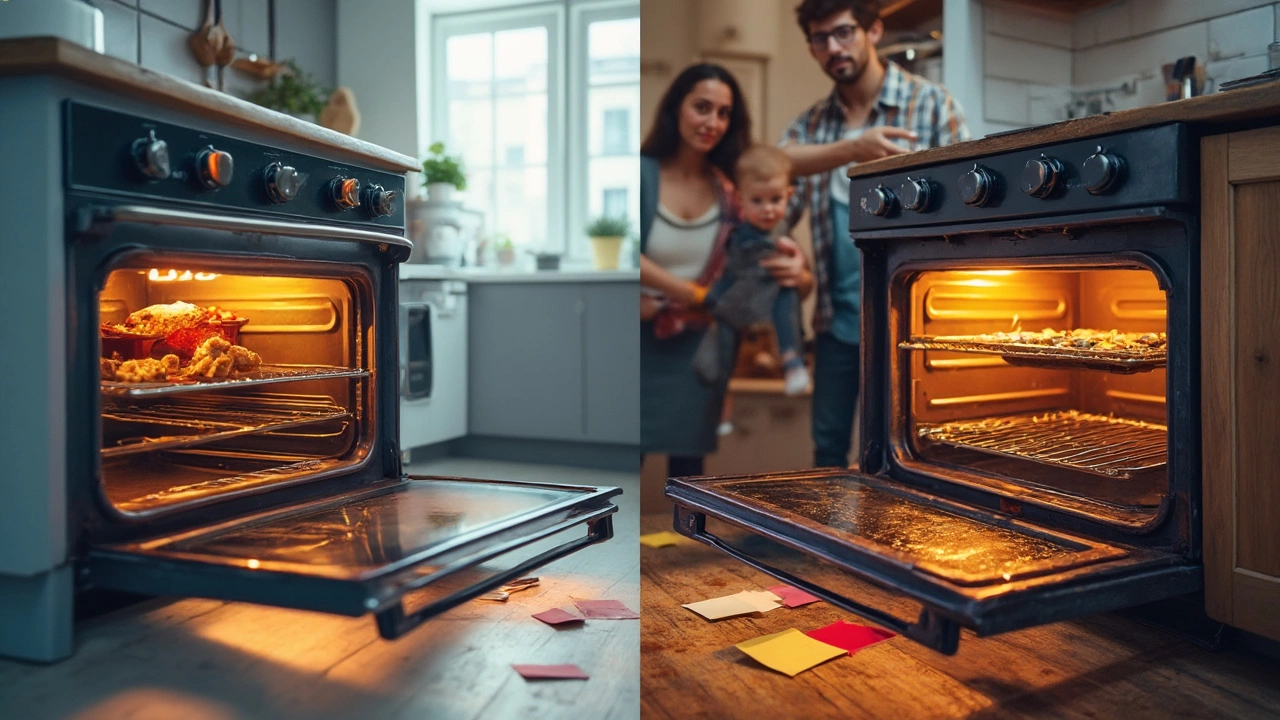Staring at a 20-year-old oven and wondering if it still deserves a spot in your kitchen? You're not the only one. These old electric ovens can seem like tanks—until one morning they won’t heat up. Suddenly, you’re facing the age-old kitchen debate: do you fix it or just buy new?
Here's what matters first—most repair guys will tell you that anything over fifteen years is already pushing it. Twenty years? That’s senior citizen territory for appliances. But just because it’s old doesn’t mean it’s totally cooked. Some issues like a busted heating element or faulty thermostat can actually be pretty easy (and cheap) to fix. But anything to do with internal electronics, a broken control board, or a dead oven sensor—that’s where things get pricey fast.
- When Should You Even Think About Repairing?
- What Are the Real Costs—Now and Later?
- How Hard Is It to Find Parts?
- Hidden Dangers of Hanging onto Old Ovens
- Repair or Replace: The Final Decision
When Should You Even Think About Repairing?
Not every old oven deserves a one-way ticket to the scrapyard. If yours is a workhorse but showing some age, there are a few things to check before you call it quits. Start with what’s actually wrong. If it’s something simple—like a heating element that won’t glow, a broken oven door handle, or a thermostat that’s acting up—these are repairs that won’t break the bank. Most fixes for these problems range from $80 to $200, much less than shelling out $700+ for a new model.
But that’s only half the story. You have to look at how often it’s breaking down, how much a oven repair will actually cost, and what’s still safe. Here’s a quick list to help you decide if it’s even worth picking up the phone for a repair:
- The oven was reliable until now, with only an occasional hiccup.
- It heats evenly—no mysterious cold spots or burning corners.
- A repair estimate is under half the price of a similar new oven.
- Replacement parts for your brand and model are still available online or in local stores.
- You don’t notice weird smells, smoke, or signs of electrical problems (like tripped breakers or buzzing sounds).
You can also weigh how much you use the oven. If it’s just for quick meals or reheating, spending a little to squeeze more life out of it makes sense. But if your oven is your main kitchen sidekick and it’s giving you grief every holiday, maybe it’s not worth the hassle anymore.
| Possible Issue | Average Repair Cost (2025) |
|---|---|
| Heating Element | $100 - $180 |
| Thermostat | $80 - $140 |
| Control Board | $250 - $400 |
| Door Handle/Hinge | $60 - $120 |
| Oven Sensor | $120 - $250 |
If your problem falls into the more expensive repair category (like control boards or sensors), think carefully. That cash might be better spent toward a new, more energy-efficient model with years of warranty, better safety, and way more features than that old clunker could ever dream up.
What Are the Real Costs—Now and Later?
Cost is where the decision gets serious. Fixing a 20-year-old oven might look cheap up front, but there’s more to it than the bill from your local repair tech. You’ve got to weigh today’s repair price against the possibility of more stuff breaking down soon.
Let’s break down the main cash hits people face:
- Service call fee: Most repair shops charge $75–$125 just to show up and diagnose your oven.
- Common part replacements: Heating elements can cost $30 to $70 for the part, plus labor. Electronic control boards? These often run $200–$350 just for the part, and sometimes aren’t even made anymore.
- Hidden extra costs: Newer oven models run on about 20% less energy versus old ones. Sticking with your old oven means your power bills probably won’t get any smaller, and that adds up over time.
Here’s a quick look at what typical repairs cost versus buying a new oven:
| Repair/Replacement | Average Cost (USD) |
|---|---|
| Service Call + Labor | $120–$200 |
| Heating Element | $120–$200 (installed) |
| Electronic Control Board | $300–$500 (installed) |
| New Basic Electric Oven | $500–$750 (delivered/installed) |
Don’t forget: big repairs on old ovens don’t guarantee you’ll get another five to ten years out of them. One recent Consumer Reports survey found that after 15 years, kitchen appliances like ovens tend to break every couple of years—and each fix costs more as parts get scarce.
So, if you’re looking at any repair over $250 and your unit’s already two decades old, it’s worth asking yourself—am I just throwing good money after bad? Are you willing to risk another breakdown and another bill next year?
If you want to keep things simple, here’s a rule a lot of pros use: if repair costs are more than half the price of a new oven, buying new usually makes more sense. You’ll save on hassle, energy bills, and the constant waiting for the next thing to quit.

How Hard Is It to Find Parts?
This is where fixing a 20-year-old oven gets messy. Parts for older electric ovens are usually way harder to track down than they were ten years ago. Brands drop support when models get old, so if you’re dealing with something that’s not a classic like a GE or Whirlpool, you could be left scouring eBay for hours, just hoping someone’s got what you need.
Even if you find parts, prices often shoot up. For hard-to-find control boards or digital displays, sellers know they have you over a barrel and markup is wild. Sometimes you’ll see a used temperature sensor going for twice what a brand new one cost back in 2012. Plus, there’s no guarantee the part is actually new—plenty of "brand new" listings on marketplace sites are really old stock, which means you’re still taking a gamble.
If your oven is from a manufacturer who’s gone out of business, consider yourself on thin ice. Companies like Tappan or Magic Chef from the early 2000s don’t make replacements anymore. You’re almost always left combing through salvage yards or appliance recycling shops. For simple stuff—like knobs, racks, or door seals—you might get lucky at a hardware store or an online universal replacement, but anything more technical? That’s usually a dead end.
Before calling a repair tech or ordering from sketchy online retailers, ask yourself these questions:
- Is your oven’s model still supported by the original manufacturer?
- Can you find the exact part number online?
- How many sellers actually have it listed—and what’s their return policy?
- Are parts for oven repair going to cost more than half a new oven?
If you answered 'no' or hesitated on most of these, finding genuine, affordable parts is probably not worth your time or money. Sometimes, the hunt itself ends up costing more than just upgrading to a newer, easier-to-fix oven.
Hidden Dangers of Hanging onto Old Ovens
Using a 20-year-old oven isn't just about dealing with outdated knobs and slow preheating. There's a real risk factor hiding behind those old panels, especially when it comes to electricity and safety. First off, the insulation inside electric ovens can break down over time. This leads to heat escaping, parts wearing out quicker, and in some cases, wiring getting brittle or exposed—yep, that's how fires start in kitchens.
Another issue: older ovens almost never have today’s safety standards. Stuff like automatic shut-offs or better temperature control sensors just wasn’t a thing back then. So if your oven is running hotter than it should or won’t turn off, it’s not just an inconvenience—it’s dangerous.
- Electrical shorts from worn wiring can trip your breakers, or worse, spark a fire.
- Old door seals let more heat escape, which makes cooking uneven and forces the oven to work twice as hard.
- Rust, moisture, and dust build-up can mess with circuits and even create shock hazards.
- If you ever smell something burning that isn’t your food, that’s a huge red flag to stop using your oven immediately.
One more thing: twenty-year-old units are known for efficiency problems. They often use more power than newer models to do the same job. If you care about your electric bill or just want to play it safe, these are real reasons to think twice about continuing with an old oven repair plan.

Repair or Replace: The Final Decision
This is the part everybody dreads, right? Spending a chunk of change to fix an old oven is stressful—especially when that oven has lived through two decades already. Here’s the bottom line: if a repair is going to cost you over half the price of a new similar model, it’s usually smarter to swap your old oven out. Most appliance pros say if repairs hit the 50% mark of replacement cost, you’re just tossing money into a black hole.
Think about the headaches, too. Finding parts for a 20-year-old unit can turn into a wild goose chase—some oven makes (like older Maytag and GE lines) are known for discontinued boards and unique pieces. Even if you get the part, it might take weeks to show up, especially if the model was popular in the early 2000s but got discontinued a decade ago.
Energy use matters more than most people think. According to the Department of Energy, newer ovens can be up to 20% more efficient compared to those built 20 years ago. That means less money wasted on power bills, and fewer baking sessions where things turn out half-cooked or uneven.
So, before you make the call, ask yourself:
- Is the oven repair cost less than half the price of a new one?
- Can you actually get the parts within a reasonable time?
- Have you already shelled out for repairs more than once in the last two years?
- Are you noticing uneven cooking or weird smells? (That last one can be a red flag for safety issues.)
If you’re checking “yes” to repair cost and parts availability, and your oven isn’t showing signs of quitting, a quick fix fixes your problem for now. But if costs are high, parts are a nightmare, and performance keeps slipping, biting the bullet and getting a new oven repair might just save you hassle and cash in the long run. Your future self—making pizza at midnight—will definitely thank you.
